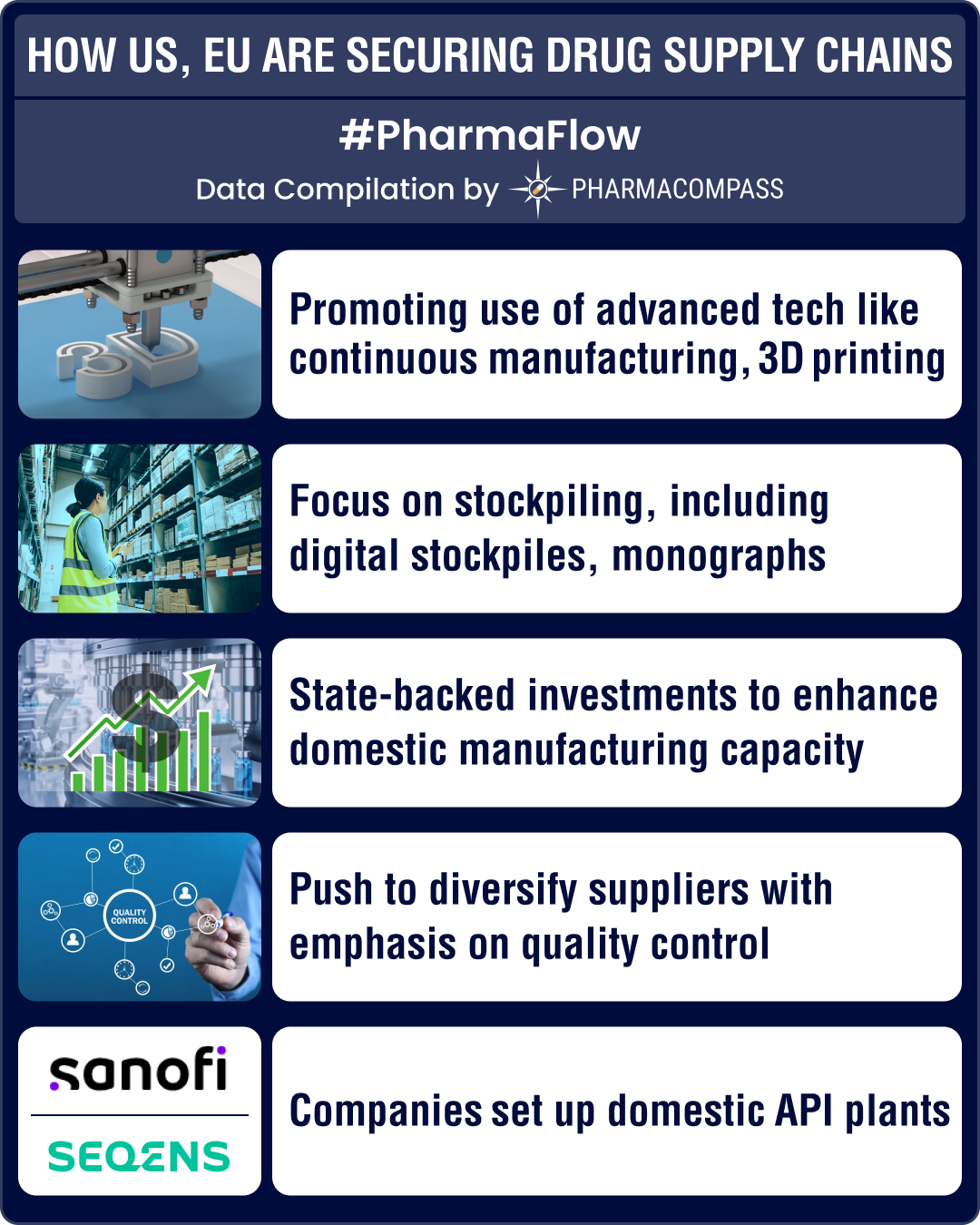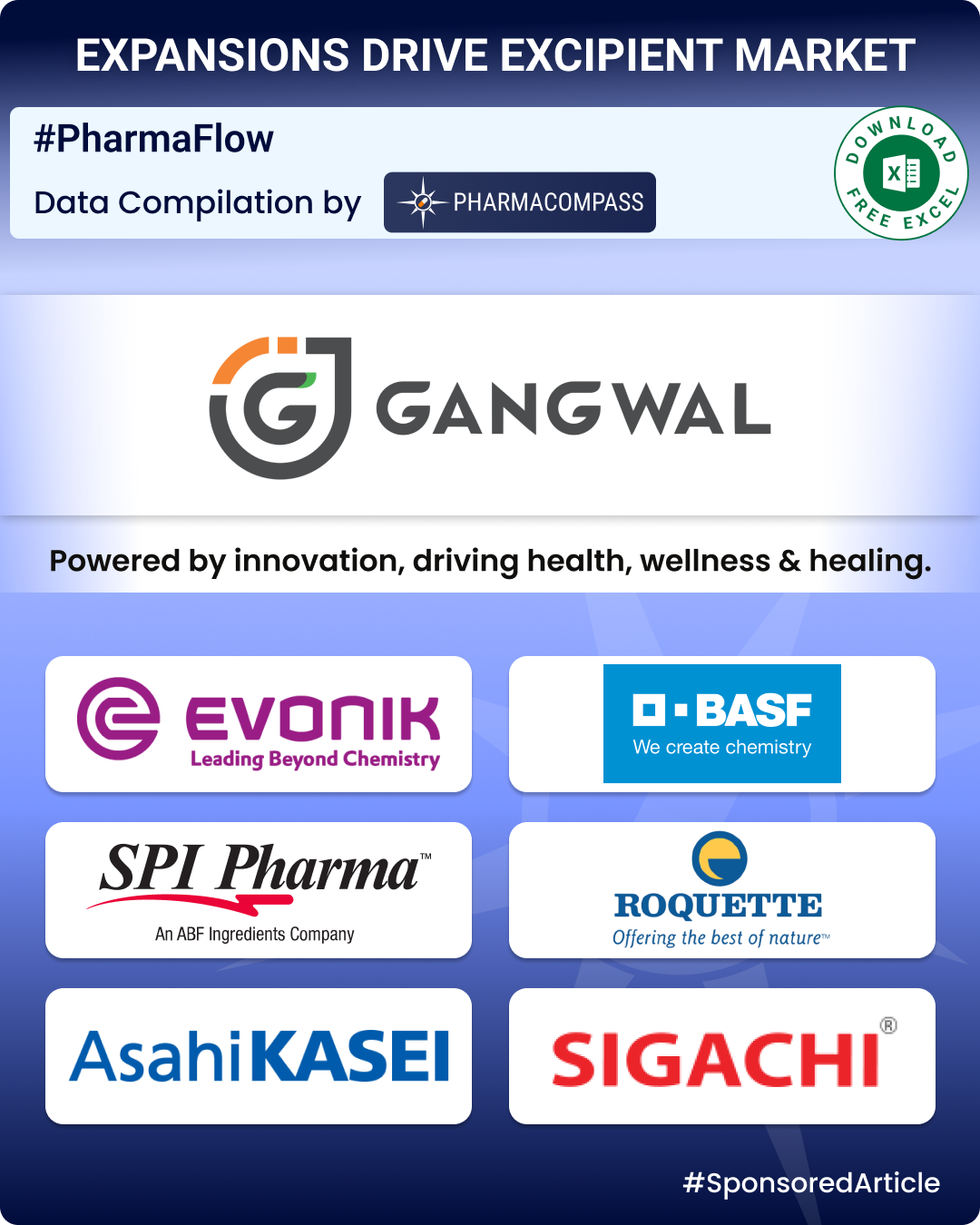
By PharmaCompass
2024-10-17
Impressions: 5133
Over the last few decades, the United States and Europe have saved trillions of dollars by importing drugs from countries like China and India. Their journey wasn’t easy, with regulatory non-compliance and drug patent scams raising their ugly heads every now and then. The Covid-19 pandemic and the accompanying lockdowns were a wake-up call for these countries to take a long, hard look at their sourcing strategies.
Over the last few years, both the US and Europe have embarked on policy changes and ambitious programs to strengthen their drug supply chains. PharmaCompass takes you through US and Europe’s journeys towards more robust pharmaceutical supply chains.
Biden’s executive order, CARES Act, state-backed investments strengthen US supply chain
During the early days of the pandemic, the US government (under former President Donald Trump) had enacted the Coronavirus Aid, Relief, and Economic Security Act (CARES Act) to address the economic fallout of the pandemic through a US$ 2.2 trillion stimulus. Through this act, the FDA had taken several drug shortage mitigation efforts.
The new administration under President Joe Biden undertook more measures. Notable amongst them was Executive Order 14017 on America’s supply chains. It mandated a comprehensive 100-day review to identify vulnerabilities in key sectors, including pharmaceuticals and active pharmaceutical ingredients (APIs). The review noted that 87 percent of generic API facilities are located overseas, leaving the US healthcare system vulnerable to shortages of essential medicines.
Through a Presidential Determination, Biden had also broadened US Department of Health and Human Services’ (HHS) authorities under the Defense Production Act (DPA) of 1950. HHS can now enable investment in domestic manufacturing of essential medicines and medical countermeasures under the DPA. The HHS has invested US$ 17 billion in domestic manufacturing for the medical supply chain, including US$ 500 million to support API manufacturing.
Under this effort, Merck has been awarded a €121 million (US$ 132 million) government contract to set up a lateral flow membrane production facility at Sheboygan, Wisconsin. Similarly, California has launched an initiative (known as CalRx) and is working with CIVICA to make US$ 30 insulin available to all who need it.
Europe encourages reshoring; EDQM develops monographs for unlicensed alternatives
In recent years, Europe has faced shortages of insulin, antibiotics, oncology drugs, corticosteroids and even paracetamol. To overcome these shortages, the European Medicines Agency (EMA) is encouraging drugmakers to enhance manufacturing capacity and diversify suppliers.
There is change visible on the ground. Companies like Midas Pharma, EUROAPI, Seqens are setting up API plants in Europe. Seqens has taken steps to reshore paracetamol production in France and is constructing a new € 100 million (US$ 109 million) production unit in Roussillon. Sanofi is investing €1.3 billion (US$ 1.4 billion) in a new insulin production facility at its existing site in Frankfurt. Similarly, Sandoz has set up a new antibiotic production plant in Austria and a new biosimilar development center in Germany.
That said, we know that manufacturing capacities take time to build and are often financially unviable in the developed world. Ergo, a particularly innovative initiative has come from the European Directorate for the Quality of Medicines & HealthCare (EDQM). Their project aims to develop monographs detailing the preparation and testing of unlicensed drugs that can fill the gap left when licensed medicinal products are unavailable. To facilitate this initiative, the European Pharmacopoeia Commission is recruiting experts to verify proposed production methods and analytical procedures.
The other means of guarding against supply and demand fluctuations is stockpiling. The EMA has advised the European Commission (EC) and marketing authorization holders (MAH) to stockpile medicines. The regulator has also asked MAHs to establish a shortage prevention plan for critical medicines. Europe’s Health Emergency Response Authority (HERA) is taking a systematic approach to stockpile management.
Despite these measures, costs and market structures pose serious challenges. Medicines for Europe, representing the generic and biosimilar medicines industry, has raised concerns about the current market structures. They argue that government purchasing practices, which prioritize obtaining the lowest prices for off-patent medicines, are jeopardizing the European manufacturing footprint and discouraging investments in supply chain resilience.
FDA, EMA promote continuous manufacturing; US relies on digital stockpiles
During the pandemic, there were acute shortages of oncology, cardiovascular, anesthesia, anti-infective, neurological and anti-allergic drugs in the US. A 2022 study undertaken by the Washington University points out that there is excess manufacturing capacity in the US that can be considered for reshoring critical and essential drugs. In fact, 49 percent of generic drug manufacturing capacity in the US is lying idle, and many others are working at less than 50 percent capacity. These capacities can be repurposed. Various advanced manufacturing technologies, such as “continuous flow and on-demand manufacturing capabilities in idled manufacturing sites offer the ability to reduce production cost,” says this report.
FDA has been promoting “advanced manufacturing” technologies, such as continuous manufacturing, which are now a part of America’s overall strategy to strengthen and secure the pharmaceutical supply chain. The EMA has also released guidelines on continuous manufacturing of drug substances and drug products.
Advanced manufacturing is a collective term for new or innovative medical product manufacturing technologies. Unlike batch manufacturing, which involves sequential processing and testing of material across multiple discrete stages (and often discrete facilities), continuous manufacturing combines the full manufacturing stream into a single, fully integrated flow. While continuous manufacturing may not be suitable for every drug manufacturing process, but where applicable, it tends to eliminate built-in production gaps and shortens the time taken to manufacture a drug from months to days.
In the US, the Strategic National Stockpile (SNS) plays a critical role in ensuring the availability of essential medical supplies during emergencies. It now also involves a digital stockpile that does not store physical goods and products. Instead, it stores electronic plans, instructions, and methods to make and test medical products. Digital stockpiles rely on one or more trusted suppliers that can make the product from the digital information, either through methods like 3D printing or self-contained distributed manufacturing lines.
Our view
The global pharmaceutical supply chain is a complex web spanning multiple countries and continents. While advanced manufacturing and stockpiling may work to an extent, a large chunk of generic drugs and APIs will continue to come from countries like China and India.
In order to reduce reliance on China, the US has been proactively expanding its collaboration with India. But this time, there is increased emphasis on quality control. While FDA is increasing the number of inspections at Indian drug plants, the Indian government, on its part, has revised rules for drug manufacturing, with higher GMP standards.
Taken together, a multi-pronged approach to addressing supply chain vulnerabilities should secure drug supplies to the US and Europe in the years to come.
The PharmaCompass Newsletter – Sign Up, Stay Ahead
Feedback, help us to improve. Click here
Image Credit : How US, EU are securing drug supply chains by PharmaCompass license under CC BY 2.0
“ The article is based on the information available in public and which the author believes to be true. The author is not disseminating any information, which the author believes or knows, is confidential or in conflict with the privacy of any person. The views expressed or information supplied through this article is mere opinion and observation of the author. The author does not intend to defame, insult or, cause loss or damage to anyone, in any manner, through this article.”








